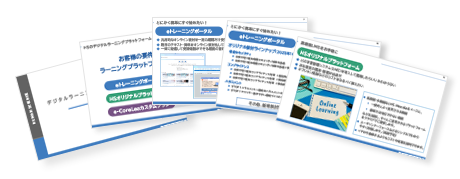2022.06.24
2022 Revised Childcare and Nursing Care Leave Law: Explaining 5 Key Revisions in an Easy-to-Understand Manner
In modern times, the declining birthrate and aging population are being called out. Balancing childcare, caregiving, and work is one of the anxieties that everyone faces. A reassuring system that alleviates such anxieties is the "Childcare and Family Care Leave Law".
The Childcare and Family Care Leave Law was revised in 2021 and is being gradually implemented from April 1, 2022.
Therefore, in this article, we will explain in detail the definition of the Childcare and Family Care Leave Act, the five revisions that were made in 2021, and how to inform employees of these revisions. We hope that this article will serve as a helpful guide for those who require childcare and family care leave.
Table of Contents
1. Background of the 2021 Amendment to the Childcare and Family Care Leave Act
2. 6 Key Points to Know About the Revised Childcare and Family Care Leave Act
① Obligation to Create a Work Environment that Makes it Easy to Take Childcare Leave (Effective April 1, 2022)
② Obligation to Provide Individual Notification and Confirm Intentions Regarding the System (Effective April 1, 2022)
③ Relaxation of Requirements for Childcare and Family Care Leave for Fixed-Term Employees (Effective April 1, 2022)
④ Establishment of Postpartum Paternity Leave System (Effective October 1, 2022)
⑤ Flexibility in Splitting Childcare Leave and Choosing the Start Date (Effective October 1, 2022)
⑥ Obligation to Disclose Information on the Status of Childcare Leave (Effective April 1, 2023)
3. How to Inform Employees about the Key Points of the Revised Childcare and Family Care Leave Act
1. Background of the 2021 Amendment to the Childcare and Family Care Leave Act
The Childcare and Family Care Leave Law has a formal name, "Law Concerning the Welfare of Workers Who Take Childcare Leave, Family Care Leave, etc." Its purpose is to create a workplace environment that allows employees to balance work and childcare/family care without having to leave their jobs. This law has established various support systems in the past.
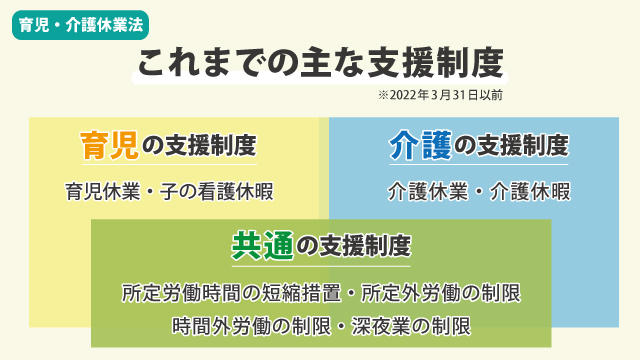
Reference: https://www.mhlw.go.jp/content/11909000/000355358.pdf
The Childcare and Family Care Leave Act was revised in June 2021. This revision included the establishment of "Postpartum Papa Childcare Leave" to promote male employees taking childcare leave, as well as the obligation to create an environment that makes it easier to take childcare leave. There were also noticeable changes to the childcare leave system. What were the factors behind these changes?
● Background of the Revised Childcare and Nursing Care Leave Law
According to the "Basic Survey on Equal Employment" announced by the Ministry of Health, Labour and Welfare, the rate of women taking childcare leave has been around 80%, while for men it is only 12.65%, showing a significant gap between men and women. With recent efforts to promote work style reform, the rate of men taking childcare leave has been increasing, but it is still at a low level.
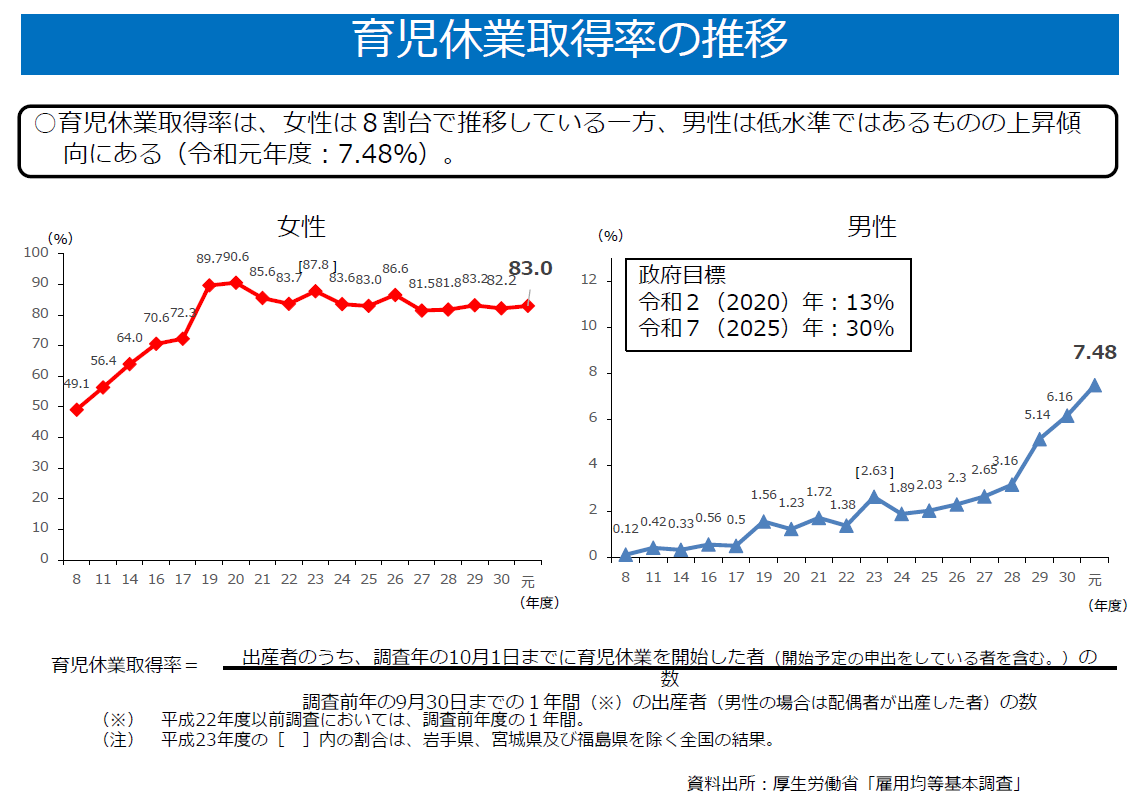
Source: https://www.mhlw.go.jp/content/11901000/000676815.pdf
In addition, according to the 15th Basic Survey on Birth Trends by the National Institute of Population and Social Security Research, it can be seen that nearly half of women choose to retire due to childbirth and child-rearing.

Source: https://www.mhlw.go.jp/content/11901000/000676815.pdf
From this data, it can be seen that while there is an increasing trend in men taking childcare leave, the situation where "women are primarily responsible for childcare and household chores" is still common.
On the other hand, among men who wished to take leave for childcare, about 40% were unable to do so due to not being able to utilize the childcare leave system, highlighting the current situation where there is not enough support for men to take leave for childcare.
Against this background, the "Measures for a Declining Birthrate Society" was decided by the Cabinet in May 2020. It includes comprehensive efforts to promote male participation in childcare, such as individual awareness and promotion of the childcare leave system for workers, creating an environment that makes it easier to take time off for childcare, and considering a framework to encourage leave for spouses immediately after childbirth. It also includes measures to make it easier for fixed-term employees to take childcare leave. As a result, this led to the revision of the Childcare and Family Care Leave Act in 2021.
2. 6 Key Points to Know About the Revised Childcare and Nursing Care Leave Law
From here, we will focus on the revised content. In this revision, the main example is the postpartum paternity leave system (childcare leave system at the time of birth), and the content aims to improve and establish an environment where anyone can easily take childcare leave regardless of gender.
〈6 Main Points of Amendments to the Childcare and Nursing Leave Law〉
① Obligation to create a work environment that makes it easier to take childcare leave (effective April 1, 2022)
② Obligation to individually inform and confirm intentions regarding the system (effective April 1, 2022)
③ Relaxation of requirements for childcare and nursing leave for fixed-term employees (effective April 1, 2022)
④ Establishment of the Postpartum Papa Childcare Leave System (effective October 1, 2022)
⑤ Flexibility in dividing and starting dates for childcare leave (effective October 1, 2022) ⑥ Obligation to disclose the status of childcare leave taken (effective April 1, 2023)
Now, let's check each revision point.
① Mandatory establishment of a work environment that makes it easier to take childcare leave (effective April 1, 2022)
In order to facilitate the smooth implementation of childcare leave requests from employees, businesses must deepen their understanding of childcare leave and create an environment that makes it easy to take childcare leave. Specifically, the following measures are recommended, and it is desirable to take multiple measures.
1. Implementation of training on childcare leave and postpartum paternity leave
2. Establishment of a consultation system for childcare leave and postpartum paternity leave (setting up a consultation desk)
3. Collection and provision of examples of childcare leave and postpartum paternity leave taken by our employees
4. Dissemination of our company's policy on childcare leave and promotion of childcare leave uptake among our employees
② Obligation to individually inform and confirm intentions regarding systems (effective April 1, 2022)
For employees who have reported their pregnancy, childbirth, etc. to the company, the company must inform them about the childcare leave system and confirm their intention to take it individually. In doing so, individual notifications or confirmations that discourage employees from taking childcare leave, such as "We have no precedent, but are you still planning to take childcare leave?" are not allowed.

Source: https://www.mhlw.go.jp/content/11900000/000789715.pdf
③ Relaxation of requirements for childcare and nursing care leave for fixed-term employees (effective April 1, 2022)
The requirements for taking childcare and nursing leave have been relaxed for fixed-term employees such as contract employees and commissioned employees. Previously, it was stipulated that the period of continuous employment must be one year or more, but with this revision, this requirement has been abolished and employees can now take childcare and nursing leave regardless of their length of employment.

Source: https://www.mhlw.go.jp/content/11900000/000789715.pdf
In addition, the requirement that "it is not clear whether the contract will expire before the child reaches 1 year and 6 months" will continue, but this will be determined by whether the labor contract is renewed between labor and management when a request for childcare leave is made.
④ Paternity Leave System After Childbirth (Childcare Leave System at Birth) Established (Effective October 1, 2022)
One of the most notable changes in this revision is the establishment of a postpartum paternity leave system. This system allows for a maximum of 4 weeks of leave within 8 weeks after the birth of a child, separate from the regular childcare leave. Immediately after giving birth, both the baby and the mother require delicate care. Taking leave during this time for men to support the mother and child can bring significant benefits.
In addition, with the postpartum paternity leave system, it is now possible to divide the maximum number of days that can be taken (up to 4 weeks) into two separate periods. This makes it easier to take leave even if you cannot be away from work for 4 weeks at a time. Furthermore, with postpartum paternity leave, if a labor-management agreement has been concluded, workers can continue to work at their workplace during their leave within the agreed upon scope. This helps alleviate concerns such as "it's difficult to take leave because there is work" and makes it easier for men to take paternity leave, leading to an improvement in the low rate of paternity leave taken by men.
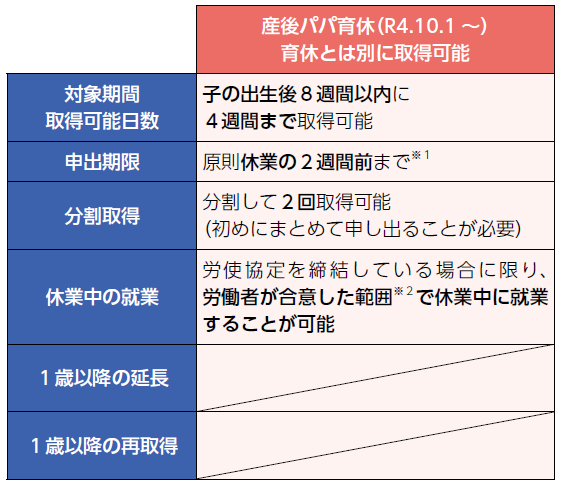
Source: Partially excerpted from https://www.mhlw.go.jp/content/11900000/000789715.pdf
⑤ Flexible division of childcare leave and flexible start date for childcare leave (effective October 1, 2022)
Just like the postpartum paternity leave system, regular childcare leave can now be divided into two separate periods for easier acquisition. This is a welcome revision for workers as it allows for more flexibility in adjusting the leave period based on family and work situations.
Furthermore, when extending childcare leave, the start date can now be set more flexibly. Previously, the start date for extended childcare leave was limited to when the child reached 1 or 1.5 years old, but with this restriction removed, it is now possible to start childcare leave in the middle of the extended period. This allows for a flexible childcare lifestyle, such as when the mother returns to work and the father takes over childcare leave, and supports a "flexible childcare lifestyle".
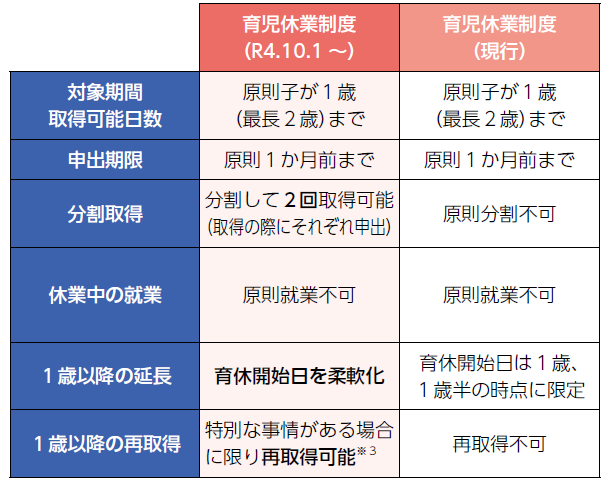
Source: Partially excerpted from https://www.mhlw.go.jp/content/11900000/000789715.pdf
⑥ Obligation to disclose childcare leave acquisition status (effective April 1, 2023)
Companies with more than 1,000 employees are now required to publicly disclose their status of taking childcare leave once a year. The disclosed information will be either the "rate of male employees taking childcare leave" or the "rate of employees taking childcare leave and parental leave for childcare purposes". The implementation will start from April 1st next year, but since data from the previous fiscal year is required, companies need to start by understanding the status of childcare leave for this year (fiscal year 2022).
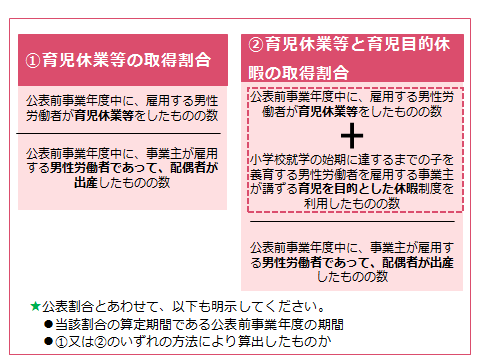
Source: https://jsite.mhlw.go.jp/tokyo-roudoukyoku/ikukai0611.html
3. How to inform employees about the points of the revised Childcare and Family Care Leave Law
The revised Childcare and Family Care Leave Act, which was amended in 2021, is being gradually implemented from this year. However, is the awareness among employees sufficient?
Childcare and family care are major issues that everyone faces at important points in their lives. That is why it is important for both the company and each employee to have a solid understanding of the key points of the revised Childcare and Family Care Leave Act and to have the correct knowledge.
Therefore, to thoroughly disseminate information, we recommend e-learning. By utilizing e-learning, employees can learn about the revised points of the Childcare and Family Care Leave Act at their own convenience, regardless of time or location. Additionally, in face-to-face training, the quality of learning may vary depending on factors such as the instructor's quality and the environment, but with e-learning, there is no need to worry about such concerns.
Human Science Co., Ltd. offers e-learning materials for learning about maternity harassment (commonly known as "mat-hara"), which is closely related to the Childcare and Family Care Leave Act. Currently, regardless of the industry or size of the company, all businesses are required to address maternity harassment, and even individual perpetrators may face disciplinary action. In other words, anyone can become a victim of maternity harassment, making it essential for all employees to have knowledge about it.
In addition, this material provides easy-to-understand explanations on various systems related to pregnancy and childbirth, in addition to the basic knowledge of maternity harassment. This article also covers the key points of the revised Childcare and Family Care Leave Act, making it possible to utilize up-to-date information for internal education.
Be sure to check it out.
STOP! Maternity Harassment ~ For Creating a Comfortable Workplace ~
Latest Blog
- 2024.04.02
- English Learning Using Moodle and ChatGPT












